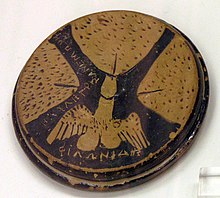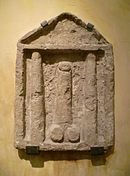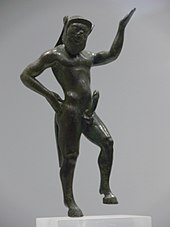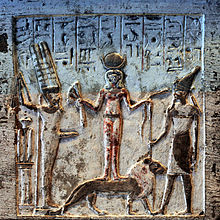phallus



As a phallus ( Latinized form of the Greek φαλλός phallus ) refers in particular cultural and historical contexts of the erect human penis . The phallus has been a symbol of strength and fertility for thousands of years .
Cultic worship
The cultic veneration of the phallus is attested in all parts of the world. Neolithic rock carvings of figures with erect limbs have been preserved from Northern Europe, suggesting a cultic significance of the phallus. Menhirs are also interpreted as phallic symbols of a fertility cult. In 2004 the Schelklingen phallus was found in the Alb-Donau district in Baden-Württemberg, the age of which was estimated to be around 28,000 years.
In Egypt , the fertility god Min , in particular, has a phallic symbolism.
In ancient Greece , the phallus is primarily associated with Dionysus and Demeter , so that here it has a clear symbolism of fertility. Also in Greece and later in the Roman Empire , large statues with enormous, erect limbs were erected in connection with the cult of Priapus . The greatly enlarged imitation of the phallus is called ithyphallus ; mainly in ancient Greece. It is a symbol of fertility and is already known in the most ancient cultures.
In Hinduism , the phallus is a symbol of the god Shiva under the name Linga . It is disputed among religious scholars whether the symbolism of a prehinduist stone cult is not having an effect here; the stone lingaform was originally not worshiped specifically as a phallus, but generally as a magical place or residence of gods.
Some peoples in southern Ethiopia (such as Burji , Hamar and Konso ) wore a phallus-like wooden object (kallacca) on their foreheads during certain traditional ceremonies , which was supposed to act as a transmitter of cosmic energy. As a result of ethnological descriptions in the first half of the 20th century, this object entered scientific literature as a phallic symbol and is now also understood as such by its wearers. In the assigned meaning, the peoples who have meanwhile converted to Christianity can better sell the Kallaccas to tourists.
Sometimes the phallus as a fascinum also had a superstitious meaning as protection against the “ evil eye ” or a purely sexual symbolism : in Pompeii in the 1st century it was sometimes a guide to brothels .
Shinto believers celebrate the Hōnen-Matsuri fertility festival in Komaki on Sunday around March 15th with large phallic symbols. The Shinto gods are asked for a rich harvest, prosperity and healthy offspring. Another fertility festival is the Kanamara Matsuri in Kawasaki .
Psychoanalysis
The phallus as a dialectical sign ( signifier ) of the body has a special meaning in the psychoanalysis of Jacques Lacan . The dialectic here lies in the unity of the “sublime” (procreation) and the “lower” (urination). The phallus does not designate the organ here, but stands as a sign for the compensation of the deficiency in the symbolic (see also castration , castration fear , penis envy ).
Phallological Museum
The Icelandic Phallic Museum (isl. Hið Íslenzka Reðasafn) in Reykjavík , as well as Haesindang Park in Korea, is dedicated to the subject of phallus .
literature
- Hans Bonnet: Phallus , in: Lexikon der Ägyptischen Religionsgeschichte , Nikol Verlag Hamburg 2000 ISBN 3-937872-08-6 pp. 590-592.
- Julius Rosenbaum : History of the lust epidemic in antiquity together with detailed studies of the Venus and phallic cults, brothels, Νούσος ϑήλεια of the Scythians, paederasty and other sexual excesses of the ancients as contributions to the correct explanation of their writings . 7th edition, H. Barsdorf, Berlin 1904, pp. 64-70 ( Phalluskultus ).
Web links
Individual evidence
- ^ Archeology: Hard facts from the Stone Age , stern.de, July 26, 2005, accessed on December 15, 2013.
- ↑ Phallus in the Lexicon of Wissen.de
- ↑ Hermann Amborn : The Phallsification of the Kallačča: or, Why sometimes a cigar is a cigar. ( Memento of the original of July 24, 2011 in the Internet Archive ) Info: The archive link was automatically inserted and not yet checked. Please check the original and archive link according to the instructions and then remove this notice. (PDF; 1.7 MB) In: Svein Ege, Harald Aspen u. a. (Ed.): Proceedings of the 16th International Conference of Ethiopian Studies. Trondheim 2009.
- ↑ http://religion.orf.at/stories/2699856/ Japanese celebrate honing festival with giant phallus, ORF.at March 15, 2015.

